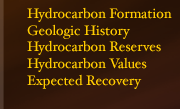
Environmental Implications - Polar Bears
ANWR is an important place not only
because of the wide variety of species that it shelters but also because
this "coastal tundra is America's only land denning habitat for
polar bears" (2). "According to studies of radio-collared
polar bears of the Beaufort Sea population between 1981 and 2000, 53
dens were located on the mainland coast of Alaska and Canada. Of these
53 dens, 22 (42%) were within the Arctic Refuge's 1002 Area" (4)†
Over the past two decades the polar bear population has been steadily
increasing, growing at more than 3% per year from 1967 to 1998, to reach
an estimated number that could be as high as 2500 animals in 2001 (3).
This rapid population growth of this species has "spanned the entire
history of petroleum development in arctic Alaska" (3) as the polar
bear population is thriving and thus will not likely be decimated even
if drilling is to negatively affect the bears. In fact in a study (Amstrup
and Durner) conducted in 1995, 85% of documented deaths of adult female
polar bears were a result of hunting and not of environmental changes
or natural factors. Although polar bear population is nearing "historic
heights" caution must be taken as "possible changes in human
activities, including hunting and habitat alterations could precipitate
further declines" (3). This point will be clarified in the next
section that discusses bears in general (of which polar bears are a
part).
Yet, according to WWF report on ANWR, polar bears are especially sensitive
to disturbance during denning. The Agreement on the Conservation of
Polar Bears committed the arctic nations to "protect the ecosystems
of which polar bears are a part, with special attention to habitat components
such as denning and feeding sites and migration patterns." Females
may abandon their dens if disturbed, and early den abandonment may be
fatal to cubs unable to fend for themselves. In 1985, a female polar
bear abandoned her maternity den in the Arctic Refuge coastal plain
after seismic exploration vehicles tracked within 700 feet of it ¡V
even though regulations at the time required a 0.8-kilometer buffer
from known dens. This occurred despite the most extensive monitoring
program ever in place for seismic exploration on the North Slope. Most
maternity den sites are never known, and therefore cannot be avoided.
Their natural curiosity and keen sense of smell often places polar bears
in harm¡œs way ¡V they can be attracted to drill rigs,
garbage dumps, and contaminants.
Polar bears are especially sensitive to oil spills because they search
for food in the open leads or broken ice where oil accumulates. Laboratory
experiments showed that oil ingested during grooming caused liver and
kidney damage.† One bear died 26 years after oiling and another
was euthanized.† However, as far as is known, neither ringed seals
or polar bears have been affected by oil spilled as a result of North
Slope industrial activities.† Yet, drilling in 1002 may have a
greater effect on polar bears as 1002 is a much more important habitat
for polar bears as discussed above.
Interactions between polar bears and humans are often lethal. A young
bear was shot in Prudhoe Bay by an oil industry employee during the
winter of 1968-69, and in 1990 a bear was killed when it approached
an offshore rig in Camden Bay, off the Refuge. (WWF's paper titled "Protection
of the Artic National Wildlife Refuge: Key to Managing one of the World's
Most Biologically Valuable Ecoregions, the Arctic Coastal Tundra")
Parameter:
Polar Bears: "A female polar bear abandoned her maternity den in
the Arctic Refuge coastal plain after seismic exploration vehicles tracked
within 700 ft of it even though regulations at the time required a 0.8
kilometer (0.5 mile) buffer from known dens. "(WWF "Protection
of the Arctic National Wildlife Refuge: Key to Managing one of the world's
most biologically valuable ecoregions, the arctic coastal tundra")
Therefore exploration and production activity should be kept at least
0.8 km away from all known areas of polar bear dens.
As previously mentioned, seismic exploration involves
the movement of
vehicles in grid patterns all across the tundra. Maternal polar bears
with their newborn cubs can be chased out of their winter dens by the
noise and vibrations and all of the human activities that come along
with the exploration activities (particularly the explosives).
Anticipated negative effects include:
a. Human-bear encounters that can be fatal to either party on many
occasions.
b. Increased mortality of cubs due to harsh winter conditions that
they're not prepared for.
Works Cited
1. Cumulative Environmental
Effects of Oil and Gas activities on Alaska¡œs
North Slope
www.nap/edu/openbook/0309087376/html
2. Save Alaska website
www.savealaska.com/sa_anwr.html
3. Arctic Refuge Coastal Plain Terrestrial Wildlife Research Summaries,
Section 8: Polar Bear
http://www.absc.usgs.gov/1002/section8.htms
4.US Fish and Wildlife Services website
http://arctic.fws.gov/issues1.html





